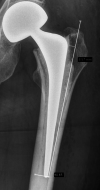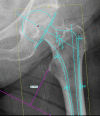Hip Hemiarthroplasty: The Misnomer of a Narrow Femoral Canal and the Cost Implications
- PMID: 34722007
- PMCID: PMC8544624
- DOI: 10.7759/cureus.18971
Hip Hemiarthroplasty: The Misnomer of a Narrow Femoral Canal and the Cost Implications
Abstract
Objective Hemiarthroplasty has been identified as the treatment of choice for displaced intracapsular femoral neck fractures. A modular prosthesis is sometimes preferred for its sizing options in narrow femoral canals, despite its higher cost and no advantage in clinical outcomes. Thus, in this study, we investigated the factors affecting surgeons' choice of prosthesis, hypothesizing that modular hemiarthroplasty is overused for narrow femoral canals compared to monoblock hip hemiarthroplasty. Methods A retrospective study of a regional level 1 trauma center was conducted. Patients who had sustained femoral neck fractures from March 2013 to December 2016 were included in this study. Inclusion criterion was modular hemiarthroplasty for a narrow femoral canal. A matched group of patients who underwent monobloc hemiarthroplasty (MH) was created through randomization. The main outcome measurements were sex, age, Dorr classification, and femoral head size. We measured the protrusion of the greater trochanter beyond the level of the lateral femoral cortex postoperatively. Modular hemiarthroplasty patients were templated on radiographs using TraumaCad for Stryker Exeter Trauma Stem (ETS®). Results In total, 533 hemiarthroplasty procedures were performed, of which 27 were modular for a narrow femoral canal. The ratio of modular to monobloc was 1:18. Average head size was 46.7 mm ± 3.6 mm for monobloc and 44.07 ± 1.5 for modular (P= 0.001). There were four malaligned stems in the monobloc group versus 14 in the modular group (P= 0.008). Unsatisfactory lateralization was noted in 18 patients (7 mm ± 2.9 mm) in the modular group compared with 8 (4.7 mm ± 3.9 mm) in the monobloc group (P= 0.029). Dorr classification was A or B in 24 patients in the modular group and 18 in the monobloc group (P = 0.006). Templating revealed that modular was not required in 25 patients. Conclusions As per our findings, it was determined that patients with a narrow femoral canal intraoperatively should not receive modular hemiarthroplasty. This is especially true for female patients with small femoral head and narrow femoral canal dimensions (Dorr A and B). They would require extensive careful planning. Surgical techniques should be explored through education intraoperatively to achieve lateralization during femoral stem preparation. This may avoid prolonged anesthetic time and achieve potential cost savings.
Keywords: cost savings; femur head; hemiarthroplasty; hip fracture; outcome; random allocation; research design; template.
Copyright © 2021, Subhash et al.
Conflict of interest statement
The authors have declared that no competing interests exist.
Figures


References
-
- Hip fracture: management. Clinical Guidelines 125, National Institute for Health and Clinical Excellence (NICE) guidance. [ May; 2017 ];https://www.nice.org.uk/guidance/cg124 Clinical Guidelines 125, National Institute for Health. 2011 - PubMed
-
- Royal College of Physicians. National Hip Fracture Database Annual Report 2017. [ Jun; 2020 ];https://www.nhfd.co.uk/
-
- A randomized controlled trial comparing the Thompson hemiarthroplasty with the Exeter polished tapered stem and Unitrax modular head in the treatment of displaced intracapsular fractures of the hip: the WHiTE 3: HEMI Trial. Sims AL, Parsons N, Achten J, Griffin XL, Costa ML, Reed MR. Bone Joint J. 2018;100:352–360. - PMC - PubMed
LinkOut - more resources
Full Text Sources
Research Materials
